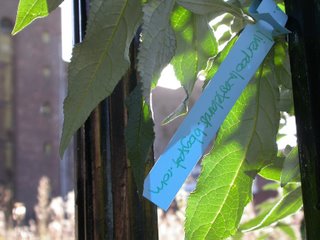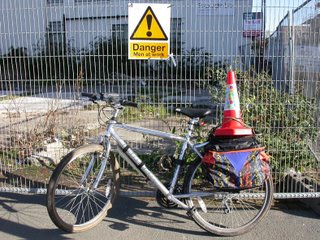

01/11/06
Brilliant sunshine, blue sky, and not a cloud in sight – a glorious autumnal day
In a corner of the city centre known as the Baltic Triangle is one of the UK’s largest exhibition spaces, the A Foundation. Launched during this year’s Biennial, it’s opening exhibition included work by Goshka Macuga, Iain Forsyth and Jane Pollard, Grizedale Arts and the Bloomberg New Contemporaries.
www.afoundation.org.uk
Outside the A Foundation is where I gracefully began my day… by falling backwards over, and landing on top of my bike… legs akimbo, and my cone crooked I worked against gravity to return both wheels and feet to the tarmac. As I approach verticality…
“Are you Kerry?”
Finally I get to meet the Creative Facilitator for the Independents Biennial, John Brady.
And for the record, the first photo of my bike and me next to a near-by White tag Brownfield – cheers John.
But I can only offer you yet another pic of my bike without me.
I make my way to a rendezvous – Fine Art students from Newcastle University visiting the Biennial. Huddled on a street corner next to a fenced Brownfield we talk about my project.
We were stood in front of a Brownfield totally covered with plant life including: clovers, mare’s tail, small Budlea bushes, dandelions, brambles, willow herb, and other tall herbs.
Could they tell me why they think spaces like this tend to be amongst our least cherished and least valued of urban habitats?
I asked them to imagine this square corner plot without the 8 ft high security fencing around it.
How does it look to them?
I can’t recall their responses in a verbatim fashion – so I’m paraphrasing
“The space has no order, it is chaotic, and spaces in chaos attract litter”
“I come from a design background, and there is no design in that space”
“I think it’s to do with social behaviour – more specifically, rooted to how we tend our gardens. It is antisocial to let your garden become overgrown with plants that we call weeds, plants that can disperse their seeds into your neighbour’s garden. So we try to keep our gardens under control. So these un-gardened spaces could be viewed as out of control, and therefore anti-social”
“But I think the space is attractive, it’s just about perception”
“If you were to remove the fence and call that space Public Art, I think more people would appreciate it”
I wish I could have spent more time with the students, but they had a hectic schedule – lots of art to see – and we were stood in shadow, and it was too bloody cold to linger.
I hope they can find some time to post their comments… I’m pretty sure what they have to say will make for interesting reading.

0 Comments:
Post a Comment
<< Home